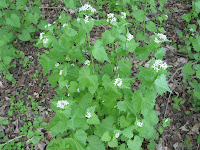
Garlic mustard is at its peak bloom in May - now. My goal is to pull as many flowering stems as possible to prevent this cohort from spreading its seeds. And I am obsessed with pulling these plants every time Bella and I head out for a walk.
Most of the invasive herbs and shrubs here are displaced from Asia. The garlic mustard (Alliaria petiolata), however, comes from a European origin; brought into the U.S. for a medicinal or herbal purpose. The plant has the faintest of onion or garlic odor when crushed. And it is in the mustard family, the Brassicaceae. I am much more fond of the mustard's cousins, the brassicas -- broccoli, cauliflower, cabbage, and friends.

Garlic mustard can grow to 3 to 4 feet. The alternate leaves are scalloped or toothed, and slightly triangular. The small white flowers, with four petals, are many, with one plant producing hundreds of tiny, black seeds. The seeds may remain viable in the soil for 5 to 10 years, so I am on a long term mission.
Fortunately the plants are relatively easy to pull, especially after the rains this week. I grab the base of the plant to pull out the entire stem including the slender white tap root. There are just so darn many of the plants. And many baby plants coming on; these will flower next year. I am motivated to keep pulling Gs because the alternative is worse. Without this control, the garlic mustard will spread into the woodlands, displacing all the woodland wildflowers such as trilliums, solomon seal's, and jack-in-the-pulpits.
 Perhaps I am fortunate that my mother is undergoing rehab for a partial hip replacement just when the garlic mustard blooms. I just happen to be here these weeks to catch the garlic mustard before it goes to seed. The pulled plants will all be taken to the burn pile in the lower field. I have only a few more days to ferret out the remaining blooms, then I can rest.
Perhaps I am fortunate that my mother is undergoing rehab for a partial hip replacement just when the garlic mustard blooms. I just happen to be here these weeks to catch the garlic mustard before it goes to seed. The pulled plants will all be taken to the burn pile in the lower field. I have only a few more days to ferret out the remaining blooms, then I can rest.




No comments:
Post a Comment